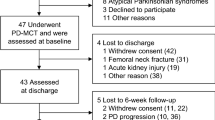Abstract
Treatment of patients with Parkinson’s disease in specialized units is quite common in Germany. Data on the benefit of this hospitalization of patients with Parkinson’s disease on motor and non-motor symptoms in conjunction with standardized tests are rare. Objective was to determine the efficacy of this therapeutic setting. We scored disease severity and performed clinical tests, respectively, instrumental procedures under standardized conditions in consecutively referred in-patients initially and at the end of their hospital stay. There was a decrease of motor and non-motor symptoms. The extent of improvement of non-motor and motor symptoms correlated to each other. Performance of complex movement sequences became better, whereas execution of simple movement series did not ameliorate. The interval for the timed up and go test went down. We demonstrate the effectiveness of an in-patient stay in a specialized unit for Parkinson’s disease. Objective standardized testing supplements subjective clinical scoring with established rating scales.

Similar content being viewed by others
References
Berg D, Godau J, Seppi K, Behnke S, Liepelt-Scarfone I, Lerche S, Stockner H, Gaenslen A, Mahlknecht P, Huber H, Srulijes K, Klenk J, Fassbender K, Maetzler W, Poewe W (2013) The PRIPS study: screening battery for subjects at risk for Parkinson’s disease. Eur J Neurol 20:102–108
Chaudhuri KR, Martinez-Martin P (2008) Quantitation of non-motor symptoms in Parkinson’s disease. Eur J Neurol 15(Suppl 2):2–7
Chaudhuri KR, Martinez-Martin P, Schapira AH, Stocchi F, Sethi K, Odin P, Brown RG, Koller W, Barone P, Macphee G, Kelly L, Rabey M, Macmahon D, Thomas S, Ondo W, Rye D, Forbes A, Tluk S, Dhawan V, Bowron A, Williams AJ, Olanow CW (2006) International multicenter pilot study of the first comprehensive self-completed nonmotor symptoms questionnaire for Parkinson’s disease: the NMSQuest study. Mov Disord 21:916–923
Chaudhuri KR, Martinez-Martin P, Brown RG, Sethi K, Stocchi F, Odin P, Ondo W, Abe K, Macphee G, Macmahon D, Barone P, Rabey M, Forbes A, Breen K, Tluk S, Naidu Y, Olanow W, Williams AJ, Thomas S, Rye D, Tsuboi Y, Hand A, Schapira AH (2007) The metric properties of a novel non-motor symptoms scale for Parkinson’s disease: results from an international pilot study. Mov Disord 22:1901–1911
Fahn S, Elton R, Members of the UPDRS Development Committee (1987) Unified Parkinson’s Disease Rating Scale. Macmillan, New York, pp 153–163
Maetzler W, Kruger R, Müller T, Oertel W, Urban P, Warnecke T, Klucken J (2016) Wearable technique for the assessment of parkinson symptoms: what’s the future? Fortschr Neurol Psychiatr 84(Suppl 1):S48–S51
Müller T (2014) Tolcapone addition improves Parkinson’s disease associated nonmotor symptoms. Ther Adv Neurol Disord 7:77–82
Müller T, Woitalla D (2010) Quality of life, caregiver burden and insurance in patients with Parkinson’s disease in Germany. Eur J Neurol 17:1365–1369
Müller T, Schafer S, Kuhn W, Przuntek H (2000) Correlation between tapping and inserting of pegs in Parkinson’s disease. Can J Neurol Sci 27:311–315
Müller T, Voss B, Hellwig K, Josef SF, Schulte T, Przuntek H (2004) Treatment benefit and daily drug costs associated with treating Parkinson’s disease in a Parkinson’s disease clinic. CNS Drugs 18:105–111
Siderowf AD, Werner RM (2001) The EQ-5D—a generic quality of life measure—is a useful instrument to measure quality of life in patients with Parkinson’s disease. J Neurol Neurosurg Psychiatry 70:817
Zampieri C, Salarian A, Carlson-Kuhta P, Aminian K, Nutt JG, Horak FB (2010) The instrumented timed up and go test: potential outcome measure for disease modifying therapies in Parkinson’s disease. J Neurol Neurosurg Psychiatry 81:171–176
Author information
Authors and Affiliations
Corresponding author
Rights and permissions
About this article
Cite this article
Müller, T., Öhm, G., Eilert, K. et al. Benefit on motor and non-motor behavior in a specialized unit for Parkinson’s disease. J Neural Transm 124, 715–720 (2017). https://doi.org/10.1007/s00702-017-1701-3
Received:
Accepted:
Published:
Issue Date:
DOI: https://doi.org/10.1007/s00702-017-1701-3




